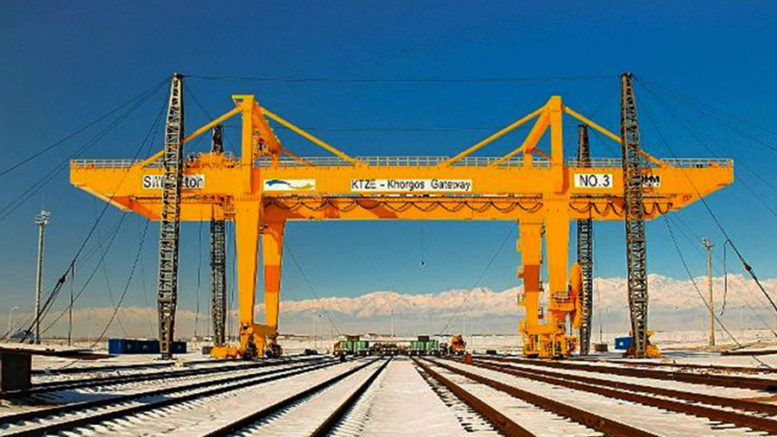Contributed by Joe Montero
less than 48 hours ago ago, China’s president Xi Jinping addressed a gathering of state leaders, including Russia’s Vladimir Putin in Beijing, where he outlined some of the details of a plan that will span 60 countries. It is called “One Belt, One Road” and the world has never seen anything like it before.
The plan first came to surface in 2013 and it is now it is poised to take off in earnest.
On the surface, this is an economic initiative. It is also much more than this. One Belt. One Road, challenges the orthodoxy imposed on the global economy by the West. A regime of unquestionable control in the hands of a few powers, backed by institutions that they have set up. Since World War Two, the United states has been the per-eminent super power in this regime, which is now under threat of losing its control.
In recent times the old order has been locked into what is generally described as neoliberal economic policy, based on minimalist government intervention and the private sector as the unchallenged economic driver. China’s initiative turns this on its head, by making government the driver and using state enterprises as the leading edge for economic transformation and growth, based on an economic plan, focusing on the longer term and adding other goals to the bottom line, like tackling the problems of poverty and the need to shift to sustainable economies.
With government intervention, projects are also secured with government backed loans to minimise risk.
It is hard to underestimate the extent of the diplomatic and therefore political impact this will have if successful. China’s own success story serves as a model. The world’s most populous nation has bee undergoing a massive industrial revolution and succeeding in spreading the benefit through its population. Some 700 million have been taken out of serious poverty.This has been achieved but by means of government intervention and leadership and not though neoliberalism.
This is why the United States, leading European powers and in Asia Japan and India are looking on with trepidation. They are not part of the plan.
The plan has already given rise to a multitude of infrastructure projects, including a $6 billion railway through the mountains of Laos to connect eight Asian countries and clearing American ordinance dropped during the Vietnam war; power plants in Pakistan to overcome an energy shortage; and another railway from Hungary to Serbia, linking to the Chinese owned port in Greece.
There is Africa’s first transnational electric railway, which opened this year and runs for 466 miles from Djibouti to Addis Ababa, the capital of Ethiopia. In Kenya, there is the railway from the port of Mombasa to Nairobi; In Indonesia, construction of a high-speed railway between Jakarta and Bandung and another railway in Thailand.
A deep water port is being built at Gwadar (Pakistan) on the Arabian Sea, linked by roads and rail that go all the way to Western China’s Xinjiang region where the Islamic Uighurs live, at the cost of $46 billion.
The more than $1 trillion package involves hundreds more projects across Asia, Africa and Europe, in a more than $1 trillion package.
While providing economic opportunities for the nations involved, the infrastructure development will forge strong diplomatic relationships, aimed at creating a political impact. It may well signal the end of Western dominance. Along with the rise of China’s own position, it brings the prospect of the rise of Asia, Africa and Eastern Europe, as collective pact that will eventually dominate the global economy and politics.
For China, this will secure more markets for what it produces, when a shrinking Western dominated global economy has dampened trade.
“President Xi believes this is a long-term plan that will involve the current and future generations to propel Chinese and global economic growth,” said Cao Wenlian, director general of the International Cooperation Center of the National Development and Reform Commission, a group dedicated to the initiative. “The plan is to lead the new globalisation 2.0.”
China’s One Belt, One Road policy stands in stark contrast to the Trump “America First” policy of the United States and efforts to create an American led policy to contain China.
From its inception, China’s direction emphasises the importance of mutual benefit and not the containment of another nation.
Australia was invited to join, but because of the alliance with the United states pointedly refused to accept the invitation. But it is impossible to ignore the emerging new global force and refusing to engage with it will come at a heavy cost and eventual isolation.
Therefore, Germany is choosing to engage and many multinational companies are already sending out feelers to ascertain the possibilities. They recognise that a new global order is emerging.
Many of the countries involved have serious needs. The Asian Development Bank estimated that emerging Asian economies need $1.7 trillion per year in infrastructure to maintain growth, tackle poverty and respond to climate warming.
These are difficult problems and it needs to be seen whether the Chinese policy and engagement will make a major contribution.
While some have tried to make comparisons with Western investment in the past, there is a marked difference. In the first place, this investment had been directed towards the development of a supply of raw materials to feed industries back home. And then the emphasis shifted towards financial transactions to buy up industries and profit from interest paid on loans.
In this case, there may be elements of the above, but this is a relatively small part. The infrastructure programs are linked to domestic industries and joint partnerships in the main. This provides the best chance of opening mutually beneficial opportunities and outcomes.


Be the first to comment on "China’s $1 Trillion plan to shake up the global economic order"